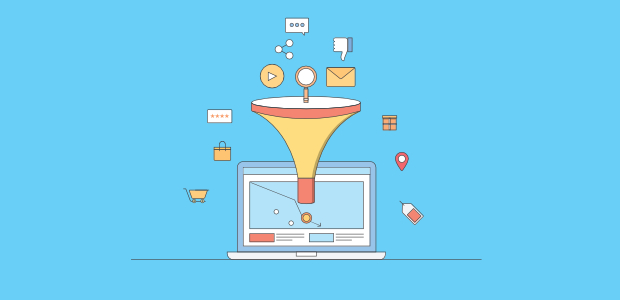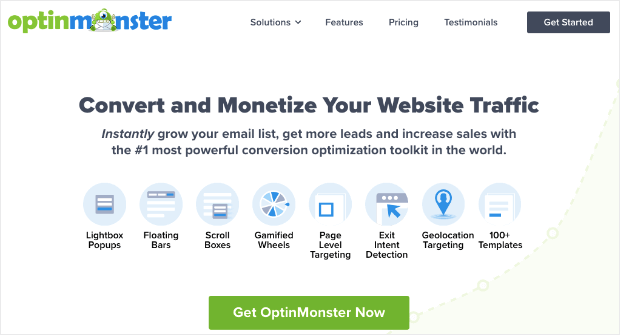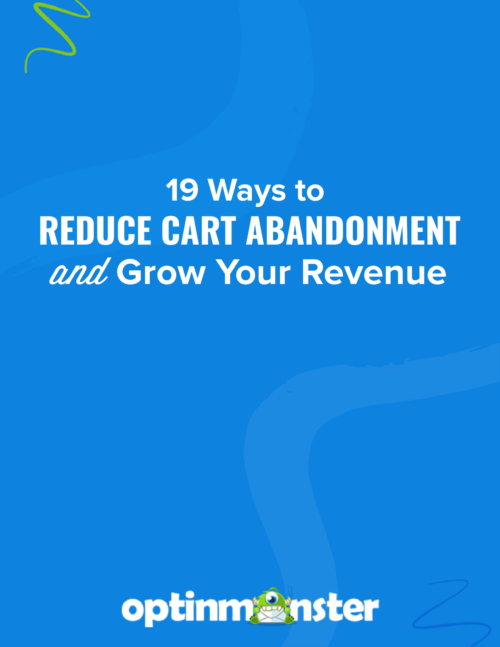In the bustling digital marketplace, your ecommerce conversion rate isn’t just a number, it’s the heartbeat of your online business.
It’s the measure of your site’s effectiveness in turning visitors into buyers, and it’s a critical factor in your store’s success.
At OptinMonster, we understand the importance of conversion rates, and we’re here to guide you through mastering them.
- What Is a Conversion
- What Is a Conversion Rate
- What Is Ecommerce Conversion Rate
- Average Ecommerce Conversion Rate Benchmarks
- What Is a Good Ecommerce Conversion Rate
- How Are Ecommerce Conversion Rates Measured
- How To Improve Your Ecommerce Conversion Rate
What Is a Conversion
A conversion is any meaningful action a visitor takes on your website that aligns with your business goals. This could be a product purchase, a newsletter sign-up, or a download of your latest e-book.
It’s the point where interest transforms into action. It is up to the business’s discretion what they define as a conversion.
What Is a Conversion Rate
Broadly, a conversion rate is the percentage of all visitors who take a desired action out of the total number of visitors. It’s a measure of your website’s effectiveness in persuading visitors to do what you want them to do.
The conversion rate is defined as a percentage and is determined using a straightforward formula:
Conversion rate = total number of specific actions within a timeframe / total number of site visits during that same timeframe
For instance, if your conversion goal is to increase downloads of an e-book and during a specific period, your site receives 2,000 visits with 200 e-book downloads, then your conversion rate would be 200 / 2,000 = 0.10 or 10%.
Recommended reading: What is a Good Conversion Rate?
What Is Ecommerce Conversion Rate
Ecommerce conversion rate specifically refers to the percentage of website visitors who make a purchase. It’s a focused metric that hones in on your site’s primary goal: selling your products or services.
When discussing the ecommerce conversion rate, the formula to calculate this is:
Ecommerce conversion rate = number of orders / number of website visits
For example, if your site receives 100 visits and achieves 5 orders, then your ecommerce conversion rate would be (5/100) = 0.05, or 5%.
The terminology for this metric can vary depending on the data source you’re consulting. In Google Analytics, for instance, it’s labeled as “ecommerce conversion rate,” which has become the standard term for this measurement.
Average Ecommerce Conversion Rate Benchmarks
The average ecommerce conversion rate is a benchmark for measuring your site’s performance against others. As per the latest study, the average ecommerce conversion rate is 3.65%.
When discussing average ecommerce conversion rates, it’s essential to consider various dimensions that can influence these figures. Here’s a breakdown of how these rates can differ across devices, industries, regions or countries, and marketing channels.
Average Rates by Device:
- Desktop: Desktop users often have higher conversion rates, sometimes averaging between 3% and 5%, due to a more stable browsing experience and easier navigation.
- Mobile: Mobile conversion rates are typically lower, averaging around 1% to 3%, partly due to the smaller screen size and sometimes less optimized mobile shopping experiences.
- Tablet: Tablet conversion rates can be similar to desktops, often falling in the 3% to 4% range, as they balance mobility and usability.
Average Rates by Industry:
- Fashion and Apparel: These sites may see higher conversion rates, around 2% to 4%, especially if they have a strong brand presence.
- Electronics: Given the higher price points and more extensive research typically involved, conversion rates might be lower, around 1% to 2%.
- Home Goods: Conversion rates in this industry vary widely but often average around 2% to 4%.
- Luxury Items: These tend to have lower conversion rates due to the high investment, often below 1%.
Average Rates by Region or Country:
- United States: The U.S. sees an average conversion rate of about 2% to 3%.
- United Kingdom: The UK often has slightly higher conversion rates, potentially 3% to 4%.
- Europe: Conversion rates in Europe can vary widely, with averages ranging from 1% to 3%.
- Asia-Pacific: This region can see lower conversion rates, often between 0.5% to 2%, due to diverse markets and consumer behaviors.
Average Rates by Channel:
- Email Marketing: This channel often sees the highest conversion rates, sometimes as high as 5% to 6%, due to its targeted nature.
- Organic Search: Conversion rates from organic search can average around 2% to 4%, as these users are often actively seeking specific products or services.
- Paid Search: Paid search conversion rates can be similar to organic, around 2% to 3%.
- Social Media: These rates are usually lower, around 1% to 2%, as users on these platforms are not always in a buying mindset.
- Direct Traffic: When users come directly to a site, conversion rates can be pretty high, around 3% to 4%, as these are often returning customers.
It’s crucial to note that these figures are averages and can fluctuate based on many factors, including market trends, seasonal campaigns, and changes in consumer behavior. For the most accurate benchmarking, businesses should compare their conversion rates against the most relevant and recent data within their niche and market.
What Is a Good Ecommerce Conversion Rate
A “good” ecommerce conversion rate is one that aligns with your specific industry benchmarks while also taking into account the unique aspects of your business.
However, it’s widely accepted that an average ecommerce conversion rate falls between 1% to 2%.
For some, a good conversion rate might be higher, especially if they are in a niche market with a strong customer base or if they have optimized their user experience and sales funnel effectively.
It’s important to remember that conversion rates can vary widely based on a number of factors, including:
- Product Type: Different industries will have different average conversion rates. For example, luxury goods may have a lower conversion rate due to their higher price points, while more affordable items may have higher rates.
- Traffic Source: Conversion rates can differ based on where your traffic comes from. Organic search traffic might convert differently than traffic from social media or email marketing.
- Market Position: If you’re a well-established brand with a loyal customer base, your conversion rates may be higher than those of a new entrant to the market.
- Website Optimization: Sites that are optimized for conversions, with a user-friendly design, clear calls-to-action, and a seamless checkout process, tend to have higher conversion rates.
- Seasonality: Conversion rates can fluctuate during different times of the year, such as holiday seasons or during sales events.
Ultimately, a good ecommerce conversion rate is one that is improving over time. It’s less about hitting a specific number and more about continually testing and optimizing your website to increase conversions relative to your past performance.
How Are Ecommerce Conversion Rates Measured
The ecommerce conversion rate of a website can be tracked using various web analytics tools, with Google Analytics being one of the most widely used, focusing primarily on data from the website itself.
However, there are several other methods to monitor this key performance indicator. Some popular alternatives include:
1. MonsterInsights
A user-friendly plugin for WordPress sites that simplifies the integration of Google Analytics, allowing for easy tracking of ecommerce conversion rates directly from the WordPress dashboard.
Recommended Reading: MonsterInsights Review: Is This Analytics Plugin Worth It?
2. Segment
This tool collects data from various platforms, including online advertising channels like Facebook and Instagram.
3. Heap
Similar to Segment, Heap compiles data from various sources and offers enhanced customization for tracking specific events, offering a different approach than Google Analytics.
4. Triple Whale
This tool provides a comprehensive view of a customer’s interactions with a brand across multiple platforms, including social media and search engines.
These analytics tools typically operate by having you insert a piece of code onto your website. This code, once configured with the help of a marketer or developer, can track the start and end of a visitor session and identify when a purchase is made.
Recommended Reading: How to Set Up Google Analytics eCommerce Tracking for WooCommerce
Choosing the most suitable analytics tool will depend on factors such as your budget, the channels through which you acquire customers, and the level of your advertising expenditure (with higher spending often necessitating more sophisticated analytics and attribution capabilities).
How To Improve Your Ecommerce Conversion Rate
Here are a few tip to improving your ecommerce conversion rate:
- Optimize Your Landing Pages: Ensure that your landing pages are compelling, with clear calls-to-action and minimal distractions.
- Enhance User Experience: A seamless user experience, especially on mobile devices, can significantly improve conversion rates.
- Personalize the Customer Journey: Use data to personalize the shopping experience, from product recommendations to personalized emails.
- Implement A/B Testing: Regularly test different elements of your website to see what changes can lead to more conversions.
- Use Urgency and Scarcity: Limited-time offers and low-stock alerts can encourage visitors to make a purchase decision more quickly.
Investing in Ecommerce Conversion Rate Optimization
In conclusion, understanding and optimizing your ecommerce conversion rate is not just about crunching numbers; it’s about diving deep into the customer journey and refining every touchpoint to turn visits into valuable conversions.
From the first click to the final checkout, every aspect of your online store should be aligned to guide potential customers toward making a purchase. This is where OptinMonster is your ally in the quest for conversion rate excellence.
With its powerful, user-friendly tools designed to capture leads, create engaging pop-ups, and segment your audience, OptinMonster is more than just a platform—it’s your strategic partner in boosting ecommerce sales.
Whether you’re looking to reduce cart abandonment, increase average order value, or get more eyes on your products, OptinMonster can help you achieve your goals.
Remember, the landscape of ecommerce is ever-evolving, and staying ahead means not only understanding your conversion rate but actively working to improve it. OptinMonster is here to ensure that your store isn’t just a destination for browsing but a hub of bustling sales activity.
So why wait? Start your journey with OptinMonster today and transform those clicks into customers.











Add a Comment